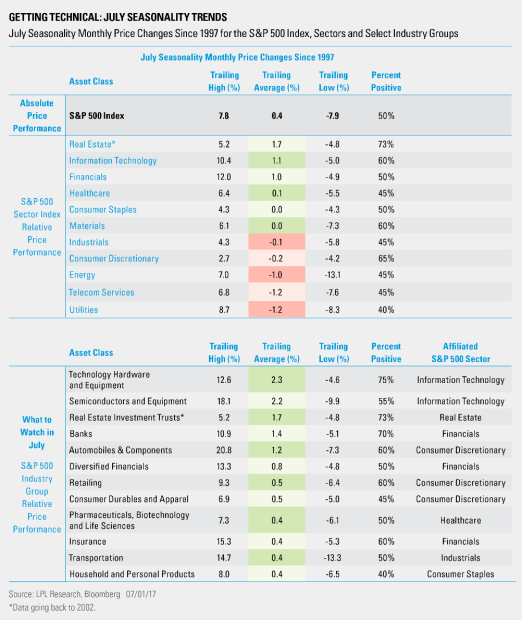by Ryan Detrick, LPL Research
Before enjoying some summer fun with family and friends, incorporating seasonal analysis into your portfolio management process could help you identify sectors and industries that may outperform the broad market in July—so your portfolio can keep working while you take a vacation.
We are encouraged by three sectors’ seasonal tendency to outperform the S&P 500 Index during July over the last 20 years—a month when the index has on average been moderately higher for equity investors, generating positive returns 50% of the time. But, when reviewing the data, we also note that nonseasonal factors still influence performance and should not be ignored.
The table below highlights sectors’ average over- and under-performance versus the S&P 500 during July since 1997, as well as the top-performing industry groups over the same period:
It’s clear that the information technology, financials, and real estate sectors have shown relative strength versus the index in July over the past 20 years, but if you’re looking for a more targeted strategy, the table also shows the industries underlying the relative strength at the sector level (i.e., “What to Watch in July”).
Drilling down even further, the information technology and financial sectors experienced broader participation in July among their underlying industries versus the real estate sector; comprising 5 of the top 12 industry categories (41%) listed within the chart. This was due in part to their market cap and overall weighting within the S&P 500.
Although the index has tended to post moderately positive returns in July, seasonal analysis can help to identify which sectors and industries may fare even better, particularly if volatility increases due to potential seasonal headwinds toward the end of the summer. Please stay tuned to the LPL Research blog for continued analysis of S&P 500 seasonal patterns.
IMPORTANT DISCLOSURES
Past performance is no guarantee of future results. All indexes are unmanaged and cannot be invested into directly.
The opinions voiced in this material are for general information only and are not intended to provide or be construed as providing specific investment advice or recommendations for any individual security.
The economic forecasts set forth in the presentation may not develop as predicted.
Investing in stock includes numerous specific risks including: the fluctuation of dividend, loss of principal and potential illiquidity of the investment in a falling market.
Stock investing involves risk including loss of principal.
The Standard & Poor’s 500 Index is a capitalization-weighted index of 500 stocks designed to measure performance of the broad domestic economy through changes in the aggregate market value of 500 stocks representing all major industries.
Because of their narrow focus, specialty sector investing, such as healthcare, financials, or energy, will be subject to greater volatility than investing more broadly across many sectors and companies.
This research material has been prepared by LPL Financial LLC.
To the extent you are receiving investment advice from a separately registered independent investment advisor, please note that LPL Financial LLC is not an affiliate of and makes no representation with respect to such entity.
Not FDIC/NCUA Insured | Not Bank/Credit Union Guaranteed | May Lose Value | Not Guaranteed by any Government Agency | Not a Bank/Credit Union Deposit
Securities and Advisory services offered through LPL Financial LLC, a Registered Investment Advisor Member FINRA/SIPC
Tracking # 1-624423 (Exp. 6/18)
Copyright © LPL Research














